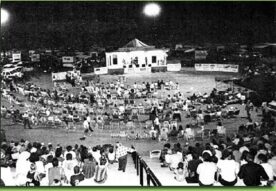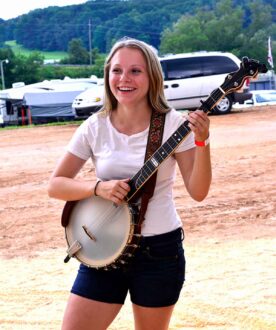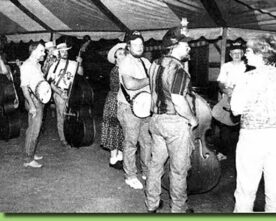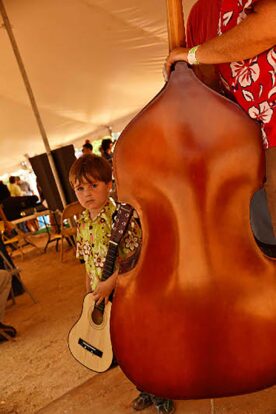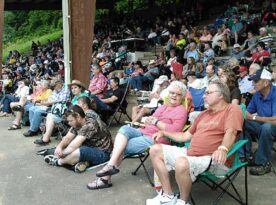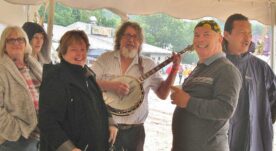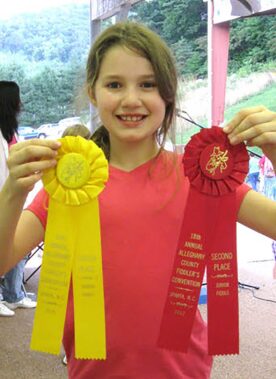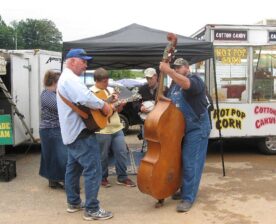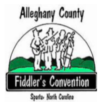
History and
What's a Fiddlers Convention
History of how we started.
The Alleghany County Fiddlers Convention has roots in the cold winter days of early 1995. Richard Nichols, maintenance engineer at Alleghany Memorial Hospital, and Dr. Jack Cahn, family practitioner, brought up the idea one day at work, said Nichols. Both are string musicians. “We got to talking about it, how we ought to have a fiddlers convention. We had a good fairgrounds, a good place to have it, and we just needed to get a group together to get it going. Raising money for the fairgrounds, that was the
intent to start with,” Nichols said The county-owned Higgins Agricultural Fairgrounds had opened not too long before and money was needed for improvements. The two men were also concerned about keeping interest in old time and bluegrass music alive. Nichols invited other Alleghany musicians and members of the fairgrounds board to join a committee to launch the first ever Alleghany County Fiddlers Convention. The first meeting was held in February 1995 in the Alleghany Memorial Hospital solarium. “It got kicked off real well because we had a good team put together,” said Nichols. A standing date was set: the third weekend in July. The committee raised money to cover prizes and expenses by selling advertisements for a printed program and signs in front of the stage. In the beginning, the signs were hand painted. Stables were among the first improvements to the new fairgrounds. Prize money and a schedule were set, and committee member David Sturgill, a judge at many conventions himself, was appointed to acquire three judges. The format for this convention was a bit different from others in the area, with the intention of making it easy for musicians to participate. Individuals and bands may compete anytime they want to Friday night and Saturday during the day. Saturday night is reserved for a band playoff. The first convention was held Friday and Saturday, July 21 and 22, 1995, with a free gospel singing on Sunday, July 23. At the time, advanced registrations were accepted by mail. Evelyn Farmer and Jesse Lovell of Fries, Virginia were the first contestants to register for the Alleghany County Fiddlers Convention. Emcees were radio personalities Sonia Joines and Harold Mitchell. At the first convention, the grandstand was uncovered. Proceeds from the convention have helped pay for larger covered seating, among other improvements. The convention was a success as a fundraiser from the beginning. The committee made a $10,000 contribution to the fairgrounds the first year. In the second year, junior band competition was added to help encourage young people to carry on the music. The gospel singing was dropped in favor of having a full day Sunday to clean up the fairgrounds. The third year, a noncompetitive children’s dance category for ages 8 and younger was added. Each child who dances gets a blue ribbon. Harmonica competition was added the fourth year. In the fifth year, 1999, junior individual categories were added for fiddle, banjo, guitar, mandolin and bass. At the time, no other conventions in this area had separate competition for youths, although several have added it since. Duet categories were added in 2018. Contestants backstage at the first convention. Proceeds from the convention have helped pay for new turnout gear, airpacks, fire hose, and other firefighting equipment. The fire department reserves the fairgrounds for two weeks before the convention and holds work details to set up big tents, put the stage in place, line off camping spaces, assemble the dance floor and a host of other chores. Beginning with the 2010 convention, the fireman accepted reservations from people who wanted to keep the camping space they held the previous year. “I hope to get to see a lot more of them,” Nichols said. “You wouldn’t believe the people who have told me how much they enjoy the fiddlers convention in Sparta, especially the young ones who are going to carry on our music for years to come.”
What is a Fiddlers Convention?
A fiddlers convention is a gathering of people who like to play string music and those who like to listen or dance. Musicians come for friendly competition, camaraderie, and to show and hone their skills. Others come to see and hear the contest, scout around the fairgrounds for hot jam sessions, kick up their heels, see their friends and neighbors, and sample the fare of a variety of vendors. Northwest North Carolina and Southwest Virginia have been called the nation’s hotbed of string musicians. You can’t turn a corner without running into someone who plays an instrument or three or four. These are people who play for fun and not for a living. Their skills, nonetheless, are amazing. In this contest, bands and individual musicians are scored by three judges who are musicians themselves. The contestants with the highest scores win cash prizes and ribbons. Here are a few more things to look for: In old time, the fiddle is the lead instrument. It stops and starts the tunes and carries the energy of the melody. Fiddle is the most difficult of the stringed instruments to learn to play, thus fiddlers are held in high regard and the contests are called fiddlers conventions. Bluegrass musicians take turns taking breaks. No single instrument is considered lead. Bluegrass fiddlers play quick and notey breaks that cascade around the melody in fast tunes, and soulful and harmonious sounds in slow tunes. Mandolins may also appear in old time bands, but being the instrument of bluegrass founding father Bill Monroe, they are associated more with bluegrass. A mandolin player will often chop rhythm besides taking breaks. Bluegrass emphasizes singing with tight harmonies. The style of banjo is also different: the way it’s played and (usually) the way it looks. Old time musicians play a clawhammer, frailing or two-finger style with no picks for a rhythmic and melodic sound. Their banjos are usually “open back.” Bluegrass banjo players use picks and play fast and rolling licks. Their banjos have a circular attachment on the back called a resonator, which projects the sound toward the listener. If you’re listening to a band and still wonder whether it’s bluegrass or old time, take a look at the crowd at the dance floor. Are they listening or dancing? Fiddlers conventions as organized events are a longstanding tradition in the Blue Ridge Mountains. A few ongoing conventions in this area date back to the 1930s. The Alleghany County Fiddlers Convention began in 1995 as a way to raise money for the new nonprofit fairgrounds, now the site of family events all year round. The event was eventually turned over to the Sparta-Alleghany Volunteer Fire Department as one of several fundraisers it holds. Part of the proceeds continue to go toward continuing improvements and maintenance at the fairgrounds. An old time contestant with an open back banjo. A bluegrass contestant with a resonator banjo Bluegrass or Old Time? What’s the difference between old time and bluegrass? That question is often heard among people who are not familiar with traditional string music. After all, the instruments are the same. Old time, as the name implies, is an older style. It developed in the nation’s infancy when people gathered to dance and socialize, often including tunes they brought from the “Old Country” and played on instruments that were small and portable. Music was passed on from person to person by ear. Since there was no amplification, the musicians played in unison for maximum rhythm and volume. The fiddle was played on the highest pitched strings so as to be heard over the noise of dancers. Other local nonprofits, including the rescue squad, other fire departments and civic organizations, raise money at the convention by selling food and other items. Bluegrass as a style developed around the time of World War II, when musicians like Bill Monroe, Lester Flatt and Earl Scruggs were experimenting with new and blended styles of playing. With electric amplification available, musicians could now show off their skills with fancy “breaks” or solos and be heard. Bluegrass evolved as music for listeners as opposed to dancers. As bluegrass solidified into a new style, fiddlers conventions began dividing up contestants in the two categories, the older one taking the name “old time.” Bluegrass is named for Bill Monroe’s home state of Kentucky, the Bluegrass State.

